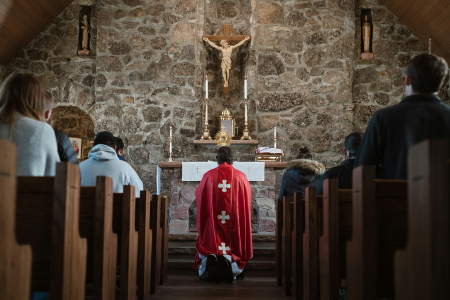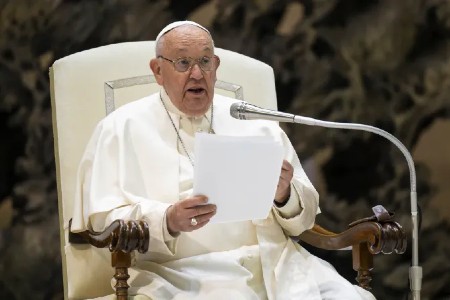St. John the Evangelist
FREE Catholic Classes
I. New Testament Accounts
II. The Alleged Presbyter John
III. The Later Accounts of John
IV. Feasts of St. John
V. St. John in Christian Art
I. NEW TESTAMENT ACCOUNTS
John was the son of Zebedee and Salome, and the brother of James the Greater. In the Gospels the two brothers are often called after their father "the sons of Zebedee" and received from Christ the honourable title of Boanerges , i.e. "sons of thunder" ( Mark 3:17 ). Originally they were fishermen and fished with their father in the Lake of Genesareth. According to the usual and entirely probable explanation they became, however, for a time disciples of John the Baptist, and were called by Christ from the circle of John's followers, together with Peter and Andrew, to become His disciples ( John 1:35-42 ). The first disciples returned with their new Master from the Jordan to Galilee and apparently both John and the others remained for some time with Jesus (cf. John ii, 12, 22; iv, 2, 8, 27 sqq.). Yet after the second return from Judea, John and his companions went back again to their trade of fishing until he and they were called by Christ to definitive discipleship ( Matthew 4:18-22 ; Mark 1:16-20 ). In the lists of the Apostles John has the second place ( Acts 1:13 ), the third ( Mark 3:17 ), and the fourth ( Matthew 10:3 ; Luke 6:14 ), yet always after James with the exception of a few passages ( Luke 8:51 ; 9:28 in the Greek text; Acts 1:13 ).
From James being thus placed first, the conclusion is drawn that John was the younger of the two brothers. In any case John had a prominent position in the Apostolic body. Peter, James, and he were the only witnesses of the raising of Jairus's daughter ( Mark 5:37 ), of the Transfiguration ( Matthew 17:1 ), and of the Agony in Gethsemani ( Matthew 26:37 ). Only he and Peter were sent into the city to make the preparation for the Last Supper ( Luke 22:8 ). At the Supper itself his place was next to Christ on Whose breast he leaned ( John 13:23, 25 ). According to the general interpretation John was also that "other disciple " who with Peter followed Christ after the arrest into the palace of the high-priest ( John 18:15 ). John alone remained near his beloved Master at the foot of the Cross on Calvary with the Mother of Jesus and the pious women, and took the desolate Mother into his care as the last legacy of Christ ( John 19:25-27 ). After the Resurrection John with Peter was the first of the disciples to hasten to the grave and he was the first to believe that Christ had truly risen ( John 20:2-10 ). When later Christ appeared at the Lake of Genesareth John was also the first of the seven disciples present who recognized his Master standing on the shore ( John 21:7 ). The Fourth Evangelist has shown us most clearly how close the relationship was in which he always stood to his Lord and Master by the title with which he is accustomed to indicate himself without giving his name: "the disciple whom Jesus loved ". After Christ's Ascension and the Descent of the Holy Spirit, John took, together with Peter, a prominent part in the founding and guidance of the Church. We see him in the company of Peter at the healing of the lame man in the Temple ( Acts 3:1 sqq. ). With Peter he is also thrown into prison ( Acts 4:3 ). Again, we find him with the prince of the Apostles visiting the newly converted in Samaria ( Acts 8:14 ).
We have no positive information concerning the duration of this activity in Palestine. Apparently John in common with the other Apostles remained some twelve years in this first field of labour, until the persecution of Herod Agrippa I led to the scattering of the Apostles through the various provinces of the Roman Empire (cf. Acts 12:1-17 ). Notwithstanding the opinion to the contrary of many writers, it does not appear improbable that John then went for the first time to Asia Minor and exercised his Apostolic office in various provinces there. In any case a Christian community was already in existence at Ephesus before Paul's first labours there (cf. "the brethren", Acts 18:27 , in addition to Priscilla and Aquila), and it is easy to connect a sojourn of John in these provinces with the fact that the Holy Ghost did not permit the Apostle Paul on his second missionary journey to proclaim the Gospel in Asia, Mysia, and Bithynia ( Acts 16:6 sq. ). There is just as little against such an acceptation in the later account in Acts of St. Paul's third missionary journey. But in any case such a sojourn by John in Asia in this first period was neither long nor uninterrupted. He returned with the other disciples to Jerusalem for the Apostolic Council (about A.D. 51). St. Paul in opposing his enemies in Galatia names John explicitly along with Peter and James the Less as a "pillar of the Church ", and refers to the recognition which his Apostolic preaching of a Gospel free from the law received from these three, the most prominent men of the old Mother-Church at Jerusalem ( Galatians 2:9 ). When Paul came again to Jerusalem after the second and after the third journey ( Acts 18:22 ; 21:17 sq. ) he seems no longer to have met John there. Some wish to draw the conclusion from this that John left Palestine between the years 52 and 55.
We ask you, humbly: don't scroll away.
Hi readers, it seems you use Catholic Online a lot; that's great! It's a little awkward to ask, but we need your help. If you have already donated, we sincerely thank you. We're not salespeople, but we depend on donations averaging $14.76 and fewer than 1% of readers give. If you donate just $5.00, the price of your coffee, Catholic Online School could keep thriving. Thank you.Help Now >
Of the other New-Testament writings, it is only from the three Epistles of John and the Apocalypse that anything further is learned concerning the person of the Apostle. We may be permitted here to take as proven the unity of the author of these three writings handed down under the name of John and his identity with the Evangelist. Both the Epistles and the Apocalypse, however, presuppose that their author John belonged to the multitude of personal eyewitnesses of the life and work of Christ (cf. especially 1 John 1:1-5 ; 4:14 ), that he had lived for a long time in Asia Minor, was thoroughly acquainted with the conditions existing in the various Christian communities there, and that he had a position of authority recognized by all Christian communities as leader of this part of the Church. Moreover, the Apocalypse tells us that its author was on the island of Patmos "for the word of God and for the testimony of Jesus ", when he was honoured with the heavenly Revelation contained in the Apocalypse ( Revelation 1:9 ).
II. THE ALLEGED PRESBYTER JOHN
The author of the Second and Third Epistles of John designates himself in the superscription of each by the name ( ho presbyteros ), "the ancient", "the old". Papias, Bishop of Hierapolis, also uses the same name to designate the "Presbyter John" as in addition to Aristion, his particular authority, directly after he has named the presbyters Andrew, Peter, Philip, Thomas, James, John, and Matthew (in Eusebius, "Hist. eccl.", III, xxxix, 4). Eusebius was the first to draw, on account of these words of Papias, the distinction between a Presbyter John and the Apostle John, and this distinction was also spread in Western Europe by St. Jerome on the authority of Eusebius. The opinion of Eusebius has been frequently revived by modern writers, chiefly to support the denial of the Apostolic origin of the Fourth Gospel. The distinction, however, has no historical basis. First, the testimony of Eusebius in this matter is not worthy of belief. He contradicts himself, as in his "Chronicle" he expressly calls the Apostle John the teacher of Papias ("ad annum Abrah 2114"), as does Jerome also in Ep. lxxv, "Ad Theodoram", iii, and in "De viris illustribus", xviii. Eusebius was also influenced by his erroneous doctrinal opinions as he denied the Apostolic origin of the Apocalypse and ascribed this writing to an author differing from St. John but of the same name. St. Irenæus also positively designates the Apostle and Evangelist John as the teacher of Papias, and neither he nor any other writer before Eusebius had any idea of a second John in Asia (Adv. haer., V, xxxiii, 4). In what Papias himself says the connection plainly shows that in this passage by the word presbyters only Apostles can be understood. If John is mentioned twice the explanation lies in the peculiar relationship in which Papias stood to this, his most eminent teacher. By inquiring of others he had learned some things indirectly from John, just as he had from the other Apostles referred to. In addition he had received information concerning the teachings and acts of Jesus directly, without the intervention of others, from the still living "Presbyter John", as he also had from Aristion. Thus the teaching of Papias casts absolutely no doubt upon what the New-Testament writings presuppose and expressly mention concerning the residence of the Evangelist John in Asia.
III. THE LATER ACCOUNTS OF JOHN
The Christian writers of the second and third centuries testify to us as a tradition universally recognized and doubted by no one that the Apostle and Evangelist John lived in Asia Minor in the last decades of the first century and from Ephesus had guided the Churches of that province. In his "Dialogue with Tryphon" (Chapter 81) St. Justin Martyr refers to "John, one of the Apostles of Christ" as a witness who had lived "with us", that is, at Ephesus. St. Irenæus speaks in very many places of the Apostle John and his residence in Asia and expressly declares that he wrote his Gospel at Ephesus (Adv. haer., III, i, 1), and that he had lived there until the reign of Trajan (loc. cit., II, xxii, 5). With Eusebius (Hist. eccl., III, xiii, 1) and others we are obliged to place the Apostle's banishment to Patmos in the reign of the Emperor Domitian (81-96). Previous to this, according to Tertullian's testimony (De praescript., xxxvi), John had been thrown into a cauldron of boiling oil before the Porta Latina at Rome without suffering injury. After Domitian's death the Apostle returned to Ephesus during the reign of Trajan, and at Ephesus he died about A.D. 100 at a great age. Tradition reports many beautiful traits of the last years of his life: that he refused to remain under the same roof with Cerinthus (Irenaeus "Ad. haer.", III, iii, 4); his touching anxiety about a youth who had become a robber (Clemens Alex., "Quis dives salvetur", xiii); his constantly repeated words of exhortation at the end of his life, "Little children, love one another" (Jerome, "Comm. in ep. ad. Gal.", vi, 10). On the other hand the stories told in the apocryphal Acts of John, which appeared as early as the second century, are unhistorical invention.
IV. FEASTS OF ST. JOHN
St. John is commemorated on 27 December, which he originally shared with St. James the Greater . At Rome the feast was reserved to St. John alone at an early date, though both names are found in the Carthage Calendar, the Hieronymian Martyrology, and the Gallican liturgical books. The "departure" or "assumption" of the Apostle is noted in the Menology of Constantinople and the Calendar of Naples (26 September), which seems to have been regarded as the date of his death. The feast of St. John before the Latin Gate, supposed to commemorate the dedication of the church near the Porta Latina, is first mentioned in the Sacramentary of Adrian I (772-95).
We ask you, humbly: don't scroll away.
Hi readers, it seems you use Catholic Online a lot; that's great! It's a little awkward to ask, but we need your help. If you have already donated, we sincerely thank you. We're not salespeople, but we depend on donations averaging $14.76 and fewer than 1% of readers give. If you donate just $5.00, the price of your coffee, Catholic Online School could keep thriving. Thank you.Help Now >
V. ST. JOHN IN CHRISTIAN ART
Early Christian art usually represents St. John with an eagle, symbolizing the heights to which he rises in the first chapter of his Gospel. The chalice as symbolic of St. John, which, according to some authorities, was not adopted until the thirteenth century, is sometimes interpreted with reference to the Last Supper, again as connected with the legend according to which St. John was handed a cup of poisoned wine, from which, at his blessing, the poison rose in the shape of a serpent. Perhaps the most natural explanation is to be found in the words of Christ to John and James "My chalice indeed you shall drink" ( Matthew 20:23 ).
Join the Movement
When you sign up below, you don't just join an email list - you're joining an entire movement for Free world class Catholic education.
-

-
Mysteries of the Rosary
-
St. Faustina Kowalska
-
Litany of the Blessed Virgin Mary
-
Saint of the Day for Wednesday, Oct 4th, 2023
-
Popular Saints
-
St. Francis of Assisi
-
Bible
-
Female / Women Saints
-
7 Morning Prayers you need to get your day started with God
-
Litany of the Blessed Virgin Mary
U.S. Catholic Parishes Experience Resurgence of Traditional Practices
-

Pope Francis Urges Faith and Prayers for Peace
-

Florida Welcomes Volunteer Chaplains to Public Schools
-
10 Fascinating Details About St. Joseph the Worker: Celebrating His Feast Day - May 1
-
St. Joseph the Worker: Model for Men, Young and Old
Daily Catholic
 Daily Readings for Thursday, May 02, 2024
Daily Readings for Thursday, May 02, 2024 St. Athanasius: Saint of the Day for Thursday, May 02, 2024
St. Athanasius: Saint of the Day for Thursday, May 02, 2024 The Our Father: Prayer of the Day for Thursday, May 02, 2024
The Our Father: Prayer of the Day for Thursday, May 02, 2024- Daily Readings for Wednesday, May 01, 2024
- St. Marculf: Saint of the Day for Wednesday, May 01, 2024
- To Saint Peregrine: Prayer of the Day for Wednesday, May 01, 2024
 Hi readers, it seems you use Catholic Online a lot; that's great! It's a little awkward to ask, but we need your help. If you have already donated, we sincerely thank you. We're not salespeople, but we depend on donations averaging $14.76 and fewer than 1% of readers give. If you donate just $5.00, the price of your coffee, Catholic Online School could keep thriving. Thank you. Help Now >
Hi readers, it seems you use Catholic Online a lot; that's great! It's a little awkward to ask, but we need your help. If you have already donated, we sincerely thank you. We're not salespeople, but we depend on donations averaging $14.76 and fewer than 1% of readers give. If you donate just $5.00, the price of your coffee, Catholic Online School could keep thriving. Thank you. Help Now >
![]()
Copyright 2024 Catholic Online. All materials contained on this site, whether written, audible or visual are the exclusive property of Catholic Online and are protected under U.S. and International copyright laws, © Copyright 2024 Catholic Online. Any unauthorized use, without prior written consent of Catholic Online is strictly forbidden and prohibited.
Catholic Online is a Project of Your Catholic Voice Foundation, a Not-for-Profit Corporation. Your Catholic Voice Foundation has been granted a recognition of tax exemption under Section 501(c)(3) of the Internal Revenue Code. Federal Tax Identification Number: 81-0596847. Your gift is tax-deductible as allowed by law.










 Daily Readings for Thursday, May 02, 2024
Daily Readings for Thursday, May 02, 2024 St. Athanasius: Saint of the Day for Thursday, May 02, 2024
St. Athanasius: Saint of the Day for Thursday, May 02, 2024 The Our Father: Prayer of the Day for Thursday, May 02, 2024
The Our Father: Prayer of the Day for Thursday, May 02, 2024
